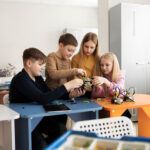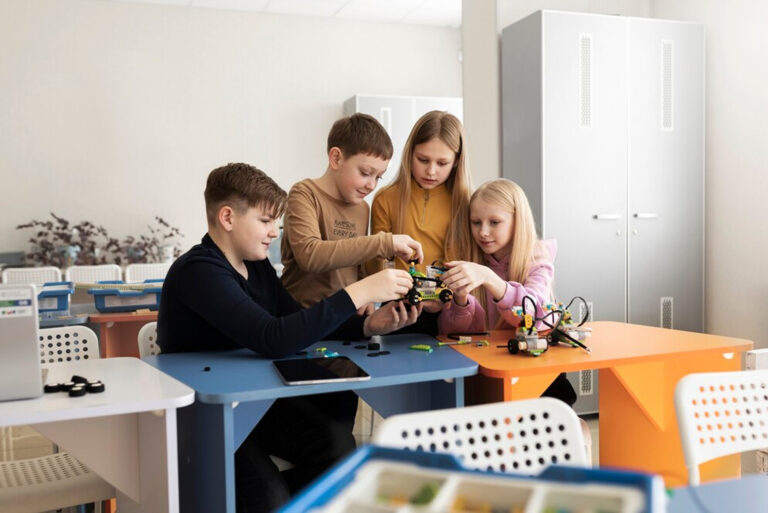In this rapidly changing world, an individual’s success seems considerably far beyond academic achievements such as test scores and report cards. While academic knowledge remains vital, there is growing recognition that students also need strong social and emotional skills to thrive, not only in school but throughout their lives. This is where socio-emotional learning (SEL) plays a crucial role, especially in the early, foundational years of primary education. Therefore, the purpose of education must go beyond academic achievements.
What is Socio-Emotional Learning
“Socio-emotional learning is a process of acquiring and applying the competencies to recognise and manage emotions, develop care and concern for others, establish positive relationships, make responsible decisions and handle challenging situations effectively” (UNESCO, 2025). In simple terms, it’s about learning to be aware of your emotions, building connections with people, resolving problems respectfully, and remaining accountable and kind.
According to Collaborative for Academic, Social, and Emotional Learning (CASEL), there are five domains of socio-emotional competencies in children: self-awareness, social awareness, self-management, relationship management, and responsible decision-making (Flowers, 2016, 99) (CASEL, 2025).
Evolution of SEL
The ancient roots of the SEL emerged from the thoughts of Plato about education in the work “The Republic”. But the modern origin of SEL began in the 1960s at the Yale School of Medicine (USA) in its child study centre (Social–emotional Learning, 2025). Following this, a group of educators and researchers, led by Timothy Shriver and Dr Roger P Weissberg, began the New Haven Social Development Program from 1987 to 1992, pioneering SEL strategies across K-12 classrooms (CASEL, 2025). In 1994, the CASEL was established with the goal of enhancing high-quality, evidence-based SEL in school education. In 1997, CASEL co-authored “Promoting Social and Emotional Learning: Guidelines for Educators”, which formally defined the field of SEL (CASEL, 2025).
The Potential of SEL in Primary Education
SEL plays a significant role in primary education by fostering the emotional and cognitive framework that is essential for a child’s overall development. During this early childhood phase, children are especially open to understanding themselves and people around them, and SEL supports a rapid development of flexible skills that significantly influence future social, academic, cognitive, and health outcomes. These socio-emotional skills are considered as a part of a person’s abilities, qualities, and characteristics that are important for individual success and social functioning (Denham & Weissberg, 2004, 13-50). Various studies indicate that, beyond simply scaffolding skills, SEL facilitates many other benefits. It helps improve students’ behaviour and reduces aggression, boosts their motivation and engagement in learning, and lowers levels of anxiety, depression, and stress (Durlak et al., 2011, 405-432).
In most education systems, usually the academic performance is measured by standardized tests which normally occupies priority. However, an innovative system will employ a holistic approach which is not only nurturing cognitive growth, but also emotional and social intelligence. This will help SEL to strengthen academics. For instance, a student who can regulate their frustration is more likely to persevere through difficult math problems. Children who show empathy towards their classmates become better team players, while self- aware students are more confident and adaptable in their learning.
In a classroom, students can practice socio-emotional learning by engaging in daily habits, and supportive interactions that foster self awareness, empathy, and positive relationships. One important method is to engage in regular scheduled activities such as journaling or group discussions, in which they identify and express their emotions, challenges, and achievements. Once in a week students can engage in any of the sports activities outside the classroom or healthy discussions during the breaks, etc.. (Zins, 2004). These activities help students to recognize their feelings and understand how emotions influence their behaviour.
Collaborative learning activities like group assignments and peer tutoring also offer opportunities to foster empathy and cooperation as students learn to listen to other’s point of view, resolve problems, and support one another in achieving common goals (Jones, 2013). In addition, using anecdotes, examples, or current incidents in a class might inspire students to consider ethical challenges while analyzing multiple points of view which would deepen their social responsibility (Durlak et al., 2011). Students who are emotionally sound and socially connected are more likely to get involved actively in their studies and make meaningful contributions to society as well.
In conclusion, education encompasses beyond just grades, tests, and completing the curriculum. What truly matters is to help children grow into kind, confident, and emotionally resilient. Socio-emotional learning enables young children to understand themselves, care for others, and face challenges effectively and wisely. When we teach children how to control emotions, collaborate with others, and make wise decisions, we are equipping the students for life, not just school.
References
CASEL. (2025). Fundamentals of SEL. CASEL. Retrieved May 7, 2025, from https://casel.org/fundamentals-of-sel/
CASEL. (2025). Our History. CASEL. Retrieved May 6, 2025, from https://casel.org/about-us/our-history/
Denham, S. A., & Weissberg, R. P. (2004). Social-emotional learning in early childhood: What we know and where to go from here. A Blueprint for the Promotion of Prosocial Behavior in Early Childhood.
Durlak, J. A., Weissberg, R. P., Dymnicki, A. B., Taylor, R. D., & Schellinger, K. B. (2011). The Impact of Enhancing Students’ Social and Emotional Learning: A Meta-Analysis of School-Based Universal Interventions. Society for Research in Child Development, 82, 405-432.
Flowers, T. (2016). Multicultural children’s literature: Review of its history and role in education. journal for the Liberal Arts and Sciences, 21, 99.
Jones, S. M. (2013). Educators’ Social and Emotional Skills Vital to Learning (S. M. Bouffard & R. Weissbourd, Eds.). Phi Delta Kappan, 94, 62-65.
Mondi, C. F., Giovanelli, A., & Reynolds, A. J. (2021). Fostering socio‑emotional learning through early childhood intervention. Springer Open. https://doi.org/10.1186/s40723‑021‑00084‑8
Social–emotional learning. (2025). Wikipedia. Retrieved May 6, 2025, from https://en.wikipedia.org/wiki/Social%E2%80%93emotional_learning
UNESCO. (2025, January 31). What you need to know about social and emotional learning. UNESCO. Retrieved May 7, 2025, from https://www.unesco.org/en/articles/what-you-need-know-about-social-and-emotional-learning
Zins, J. E. (2004). Building Academic Success on Social and Emotional Learning: What Does the Research Say? (R. P. Weissberg, M. C. Wang, & H. J. Welberg, Eds.). Teachers College Press.
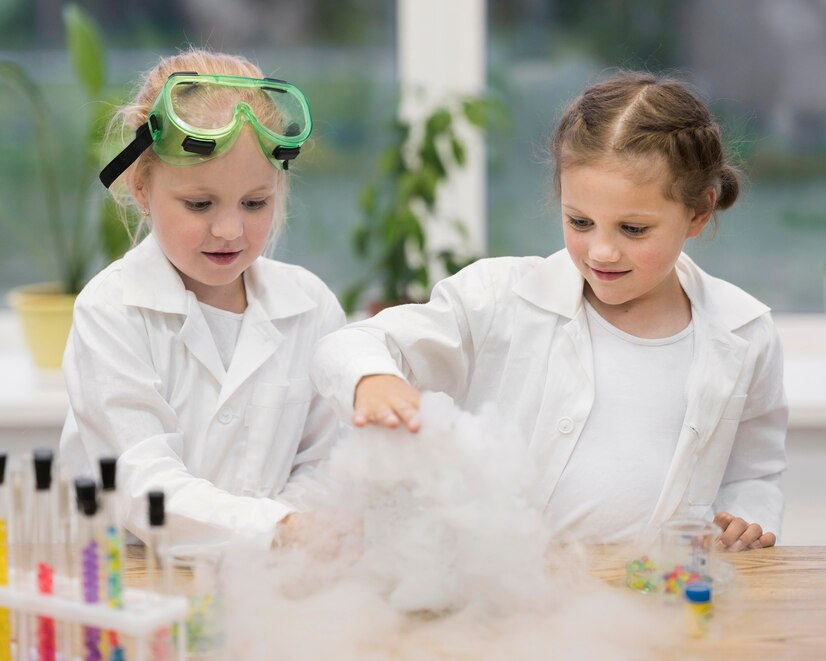
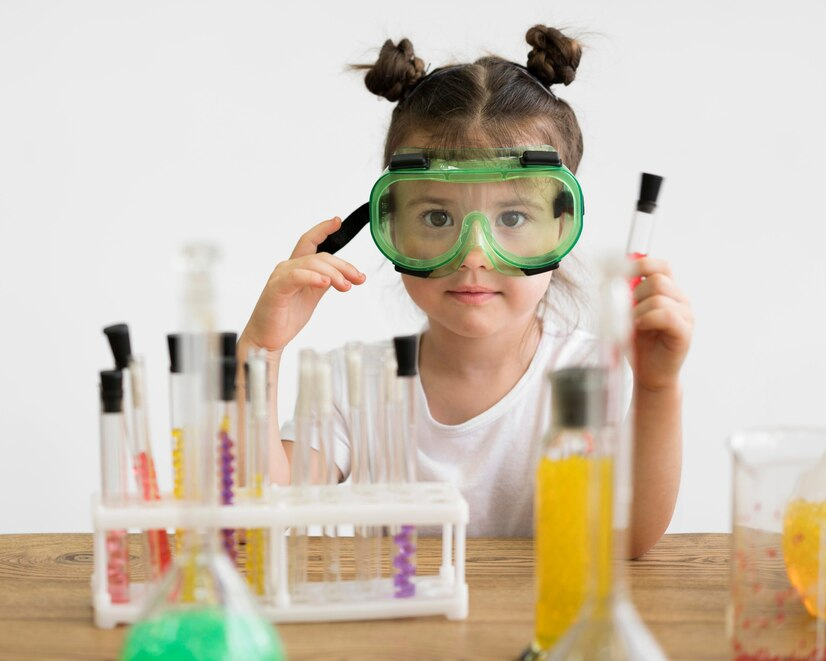
Why an Ecosystem Model?
The fourth Sustainable Development Goal (SDG 4) set by the United Nations is clear and ambitious: “Ensure inclusive and equitable quality education and promote lifelong learning opportunities for all.” While this vision is global, its true impact is rooted in local actions—especially in a country as diverse and dynamic as India.
To move toward this goal, a paradigm shift in education is not only needed—it’s essential. Traditional, siloed models of education no longer serve the demands of today’s world. What’s needed is a broader, more integrated approach—an education ecosystem model that connects learners with their communities, real-world contexts, and a network of collaborative support systems.
STEM @ school
Building the Ecosystem: Who Plays a Role?
Creating a learning ecosystem requires collaboration across sectors. Here’s how different players can contribute:
- Schools and Educators: Act as facilitators and hubs, connecting learners to opportunities and resources beyond the traditional curriculum. Teachers evolve into mentors who guide inquiry and nurture curiosity.
- Government Bodies: Can provide the policy framework, funding, and infrastructure to support integrated learning models. They also play a key role in ensuring educational equity.
- NGOs and Social Enterprises: Bring grassroots understanding and innovative models to support underserved communities, particularly in rural and marginalized settings.
- Startups and EdTech Companies: Offer scalable solutions that bring STEM, sustainability, and skills-based education to life in interactive ways.
- Libraries, Museums, and Community Centers: Serve as vital access points for informal learning, cultural exchange, and lifelong exploration.
- Parents and Local Communities: Play a pivotal role in contextualizing education within local realities, values, and traditions, making it more relevant and impactful.
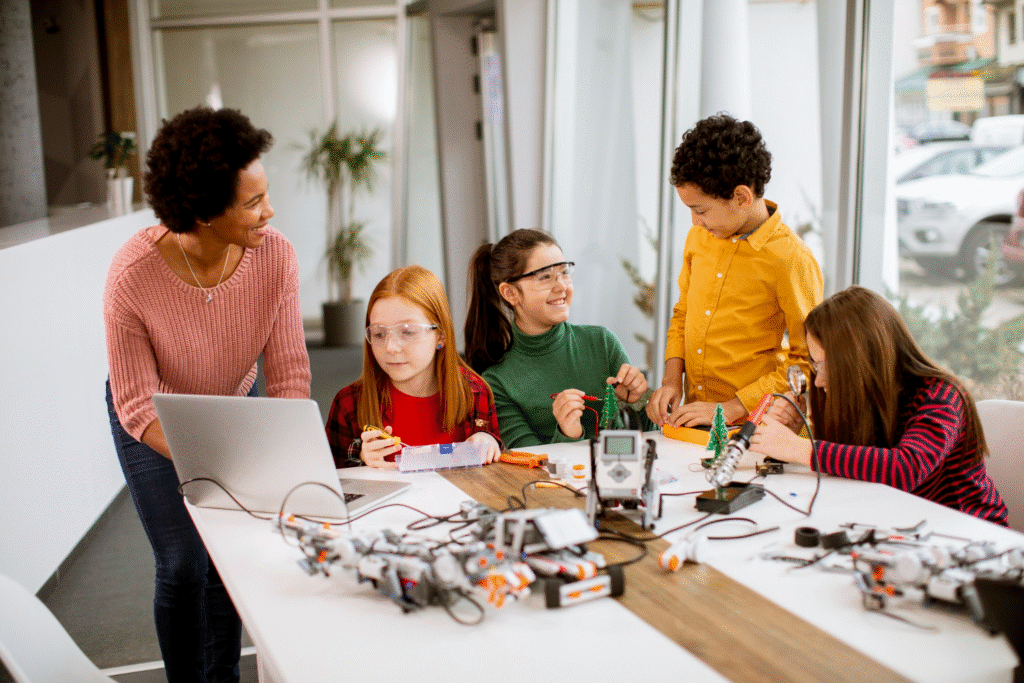
Sustainability at the Core of Learning
In the ecosystem model, sustainability is not a stand-alone subject but a cross-cutting theme. From science and technology to art and social studies, sustainability thinking is integrated into every area. Students engage in projects related to climate change, energy conservation, biodiversity, waste management, and social equity—developing critical thinking and a sense of responsibility toward their environment and community.
These experiences aren’t theoretical—they’re hands-on, localized, and impactful. Whether it’s measuring water usage at school, building solar-powered models, or conducting clean-up drives, students learn by doing—and in doing so, they become agents of change.


